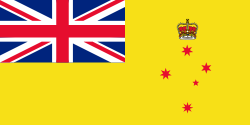
Flag of Victoria
Encyclopedia
.svg.png)

The flag of Victoria, symbolising the state
States and territories of Australia
The Commonwealth of Australia is a union of six states and various territories. The Australian mainland is made up of five states and three territories, with the sixth state of Tasmania being made up of islands. In addition there are six island territories, known as external territories, and a...
of Victoria in Australia
Australia
Australia , officially the Commonwealth of Australia, is a country in the Southern Hemisphere comprising the mainland of the Australian continent, the island of Tasmania, and numerous smaller islands in the Indian and Pacific Oceans. It is the world's sixth-largest country by total area...
, is a British
Union Flag
The Union Flag, also known as the Union Jack, is the flag of the United Kingdom. It retains an official or semi-official status in some Commonwealth Realms; for example, it is known as the Royal Union Flag in Canada. It is also used as an official flag in some of the smaller British overseas...
Blue Ensign
Blue Ensign
The Blue Ensign is a flag, one of several British ensigns, used by certain organisations or territories associated with the United Kingdom. It is used either plain, or defaced with a badge or other emblem....
defaced
Defacement (flag)
Defacement is a term used in heraldry and vexillology to refer to the addition of a symbol or charge to another flag. For example, the Australian flag is the British Blue Ensign defaced with the Southern Cross in the fly and the Commonwealth Star in the lower hoist quarter, beneath the Union...
by the state badge of Victoria in the fly. The badge is the Southern Cross
Crux
Crux is the smallest of the 88 modern constellations, but is one of the most distinctive. Its name is Latin for cross, and it is dominated by a cross-shaped asterism that is commonly known as the Southern Cross.-Visibility:...
topped by an imperial crown, which is currently the St Edward's Crown. The stars of the Southern Cross are white and range from five to eight points with each star having one point pointing to the top of the flag. The flag dates from 1877, with minor variations, the last of which was in 1953.
Previous flags
The first flag of Victoria was adopted in 1870 and was first flown from HMVS Nelson on 9 February 1870. It too was a defaced British Blue Ensign with the Southern Cross located in the fly. The stars of the Southern Cross are white and have 5, 6, 6, 7, 8 and 9 points with each of the stars having one point pointing to the top of the flag. The adoption of the flag came about when Victoria became the first Australian colonyColony
In politics and history, a colony is a territory under the immediate political control of a state. For colonies in antiquity, city-states would often found their own colonies. Some colonies were historically countries, while others were territories without definite statehood from their inception....
to acquire a warship, and thus under the British Colonial Naval Defence Act of 1865 Victoria needed a flag to distinguish its ships from other British ships. At the same time, the red ensign was incorrectly authorised for use by civil vessels registered in the colony of Victoria. Despite the invalid authorisation, the flag continued to be used, and was flown alongside the Union flag during federation celebrations in 1901. The red ensign did not track changes to the blue ensign, and so no crown was added, nor did the stars rotate to point upwards.
Victoria then adopted the current flag in 1877 with the stars of the southern cross from then on have 5, 6, 7, 7 and 8 points. The depictions of the crown have varied in accordance with heraldic fashion and the wishes of the monarch of the time. During Queen Victoria
Victoria of the United Kingdom
Victoria was the monarch of the United Kingdom of Great Britain and Ireland from 20 June 1837 until her death. From 1 May 1876, she used the additional title of Empress of India....
's reign, the crown had slightly dipped arches. From c. 1901–1952, during the reigns of Kings Edward VII
Edward VII of the United Kingdom
Edward VII was King of the United Kingdom and the British Dominions and Emperor of India from 22 January 1901 until his death in 1910...
, George V
George V of the United Kingdom
George V was King of the United Kingdom and the British Dominions, and Emperor of India, from 6 May 1910 through the First World War until his death in 1936....
, Edward VIII
Edward VIII of the United Kingdom
Edward VIII was King of the United Kingdom and the Dominions of the British Commonwealth, and Emperor of India, from 20 January to 11 December 1936.Before his accession to the throne, Edward was Prince of Wales and Duke of Cornwall and Rothesay...
and George VI
George VI of the United Kingdom
George VI was King of the United Kingdom and the Dominions of the British Commonwealth from 11 December 1936 until his death...
the depiction of the crown known as the "Tudor Crown
Tudor Crown
The Tudor Crown, also known as the King's Crown or Imperial Crown, was a symbol used from 1902 to 1953 representing not only the British monarch personally, but also "The Crown", meaning the sovereign source of governmental authority...
", with domed arches, was used. In 1953 the Tudor Crown was replaced with the St Edward's Crown.

